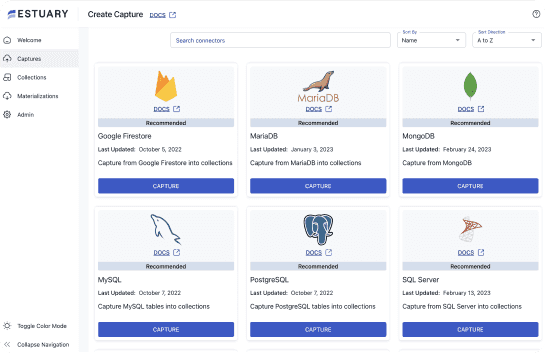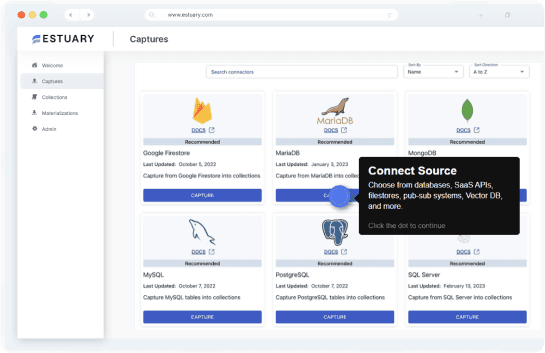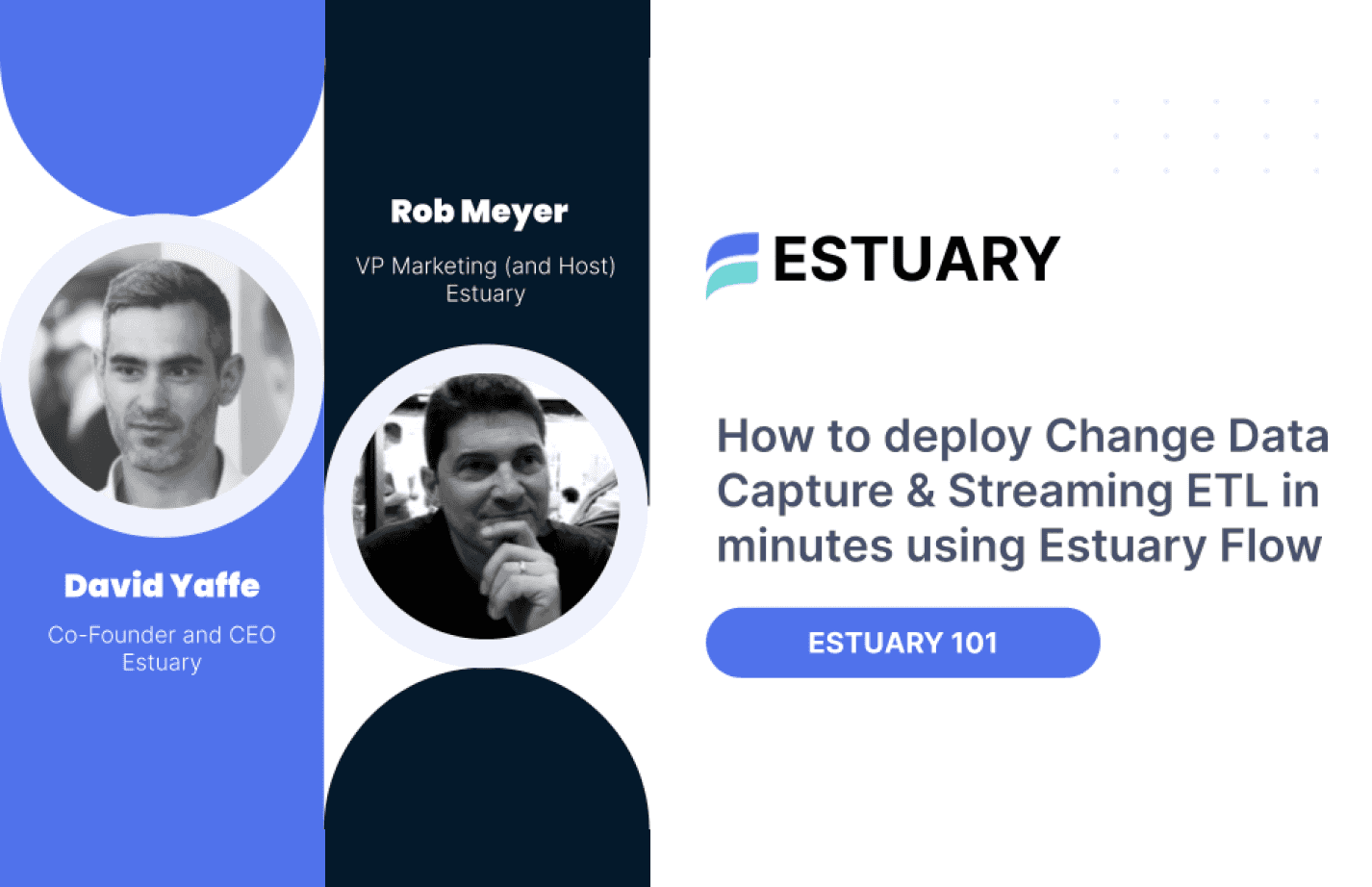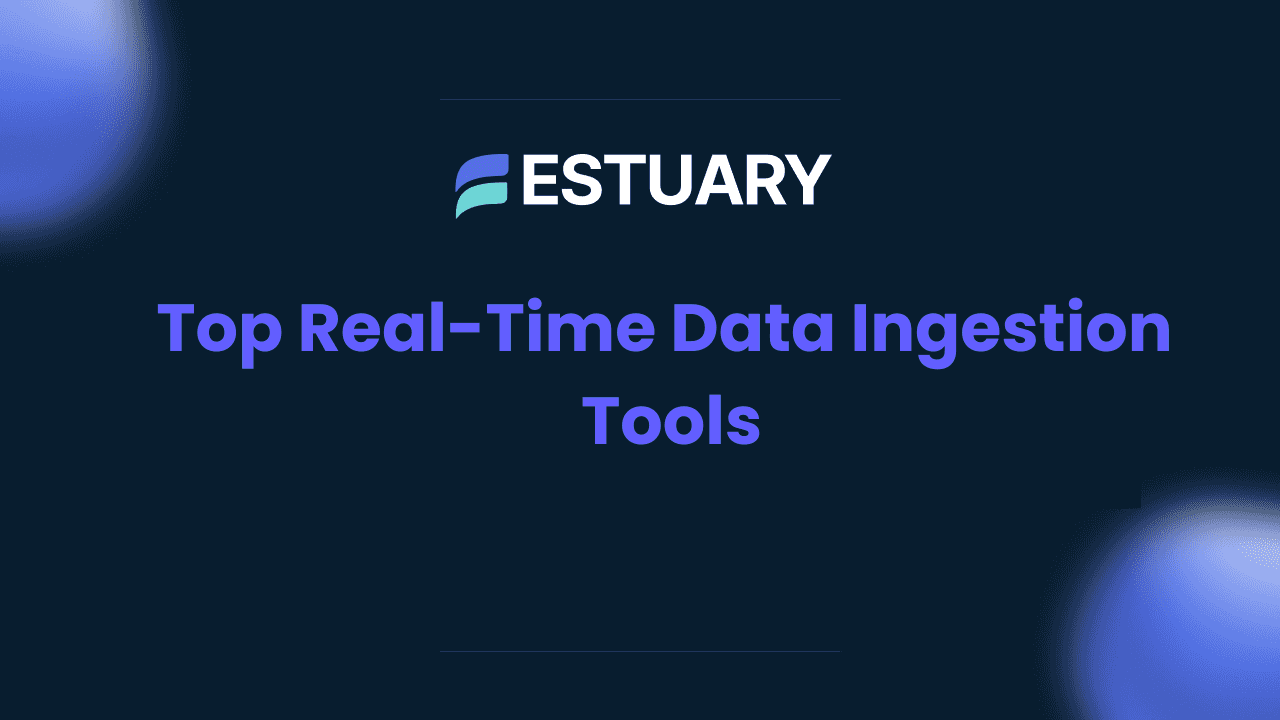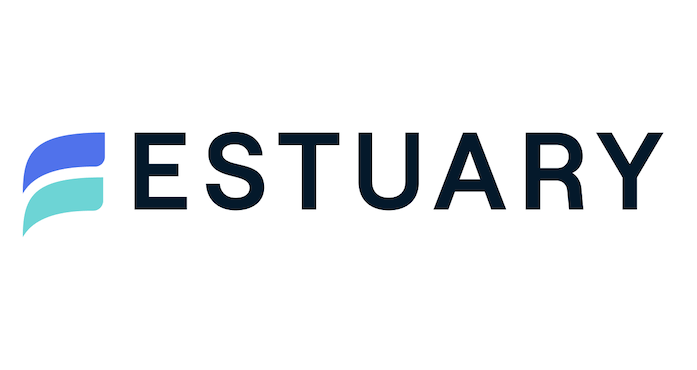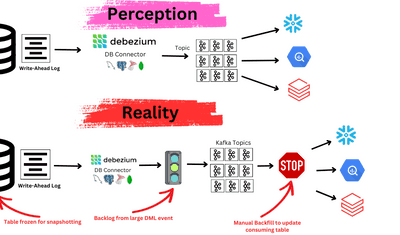
Real-time data ingestion tools help businesses process and analyze data instantly, ensuring minimal delay between data generation and action. Unlike batch processing, which collects data at scheduled intervals, real-time ingestion enables continuous data flow, allowing companies to respond to critical events as they happen.
Some of the best real-time data ingestion tools include Estuary Flow, Apache Kafka, Apache Flink, Amazon Kinesis and Google Cloud Pub/Sub. These tools empower businesses to build scalable, high-performance data pipelines for use cases like fraud detection, IoT analytics, system monitoring, and personalized user experiences.
In this guide, we’ll cover:
- What is real-time data ingestion? – A breakdown of how real-time ingestion works and why it’s crucial.
- Real-time vs. near real-time processing – Understanding the key differences.
- Best real-time data ingestion tools – A review of top tools like Kafka, Estuary, and Kinesis.
If you’re looking to build a real-time data pipeline and leverage live analytics, let’s dive in!
What is Real-time Data Ingestion?
Real-time data ingestion is all about processing data as soon as it's generated without any noticeable delay. Similar to how humans listen and respond in real-time during conversations, real-time data ingestion tools allow systems to capture and process data continuously.
Designed to handle data immediately, real-time ingestion can be crucial for applications where every millisecond matters. This real-time data might come from dynamic systems that constantly change.
Example: A stock trading platform must process market fluctuations in real time to execute trades instantly.
What is Near Real-time Data Ingestion?
Near real-time data ingestion introduces a slight delay (usually a few seconds to minutes) between data generation and processing. This approach balances speed, cost, and system complexity, making it suitable for use cases where instant updates are not crucial but fast insights are still valuable.
Example: A web analytics tool updates traffic reports every minute instead of every second to optimize system performance.
When to Choose Real-Time vs. Near Real-Time Data Ingestion Tools
Choosing between real-time and near real-time ingestion tools depends on your business needs, data processing requirements, and cost considerations.
Choose a Real-Time Data Ingestion Tool If:
- Instant event processing is critical – Ideal for fraud detection, AI-driven personalization, and system monitoring.
- Delayed insights could lead to losses – Essential for algorithmic trading, cybersecurity threat detection, and emergency alerts.
- Continuous, uninterrupted data streams are required – Used in IoT analytics, real-time dashboards, and live customer interactions.
Choose a Near Real-Time Data Ingestion Tool If:
- A slight delay (a few seconds to minutes) is acceptable – Suitable for website traffic updates, social media analytics, and batch reporting.
- You want to reduce infrastructure costs – Balances speed with affordability, reducing computational overhead.
- Event-by-event tracking isn’t necessary, but fast insights matter – Works well for log processing, marketing analytics, and operational reporting.
TL;DR: If milliseconds matter, go with real-time ingestion. If cost efficiency and slight delays are acceptable, near real-time ingestion is a better fit.
Factors to Consider When Choosing Real-Time Data Ingestion Tools
Selecting the right real-time data ingestion tool depends on your scalability, latency, cost, and security needs. Here are the key factors to evaluate:
- Scalability & Performance – Can the tool handle high-throughput data streams with low latency (e.g., Kafka, Flink)? Does it scale efficiently with demand?
- Integration & Ecosystem – Does it support cloud platforms (AWS, GCP, Azure) and integrate with data lakes, databases, and streaming frameworks (e.g., Spark, Flink, Estuary Flow)?
- Latency & Data Freshness – Does it provide millisecond-level processing and handle out-of-order events, buffering, and backpressure effectively?
- Cost & Infrastructure – Open-source tools like Kafka reduce licensing costs but require maintenance, while managed services like Kinesis & Pub/Sub simplify operations but may have higher cloud costs.
- Security & Compliance – Ensure the tool supports encryption, role-based access control (RBAC), and compliance standards like GDPR, HIPAA, or SOC 2.
5+ Best Real-Time Data Ingestion Tools
Below are some of the top real-time data ingestion tools on the market, each offering unique features for different use cases.
Estuary Flow
Estuary Flow sets itself apart from other real-time data ingestion tools by prioritizing user accessibility. It offers a managed service that reduces reliance on expert engineers, allowing other team members to actively participate in managing data pipelines.
Key Features & Benefits
- No-Code & Low-Code Integration – Easily configure real-time pipelines without complex engineering.
- Built-In Connectors – Supports databases, cloud storage, message queues, and SaaS applications out of the box.
- Change Data Capture (CDC) Support – Enables real-time database replication for analytics and ETL.
- Reliable & Scalable – Uses micro-transactions to ensure consistency, even during failures.
- Customizable Transformations – Process, filter, and enrich streaming data on the fly.
Estuary Flow’s user-friendly interface and shared visibility make it an excellent choice for small to medium-sized enterprises needing real-time data ingestion without a large development team.
Apache Kafka
Apache Kafka sets itself apart from the crowd as the Gold Standard for real-time data ingestion. It has become such an obvious choice for so many people as it provides a high-throughput, distributed, and fault-tolerant platform for streaming data between applications and systems, and is used by companies such as LinkedIn, Netflix, and Uber to power their data pipelines. These titans of the industry often make good technological choices, so it is a good litmus test to show how well renowned it is.
Key Features & Benefits
- High Throughput: Kafka is capable of handling millions of events per second which is frankly absurd. This makes it more than suitable for processing large volumes of data in real time. Its high performance is primarily due to its distributed architecture and efficient message passing.
- Scalability: Kafka's distributed architecture allows for seamless horizontal scaling. Systems rarely exist in a steady state and as your data processing needs grow, you can easily add more broker nodes to your Kafka cluster to increase throughput and storage capacity.
- Integration & Ecosystem: Kafka integrates seamlessly with other stream processing frameworks, such as Apache Flink or Kafka Streams, enabling you to perform complex event processing, data enrichment, and transformations in real-time.
Apache Flink
Apache Flink is the Porsche of the real-time ingestion world. It offers low-latency and high-throughput data processing, which is highly performant and scalable. It excels at real-time due to its stateful computation and native support for event time which make it a formidable tool when dealing with the minefield that is real-time event processing.
Developed by the Apache Foundation, it has gained significant popularity in recent years for its ability to handle both real-time and batch data processing - now they are just showing off!
Key Features & Benefits
- Unified Stream and Batch Processing: The unique selling point of Flink is its ability to handle both stream and batch processing seamlessly, so if you have an integrated system, then Flink can handle that with ease. This massively reduces the headache and effort of maintaining independent systems, which makes it a hugely versatile tool.
- Event Time Processing: Flink supports event time processing, which enables the accurate handling of out-of-order events and late data. In the real world, this is commonplace in highly dynamic systems like sensors on a car or stock market information.
Amazon Kinesis
Not all people will be looking to spend large amounts of time and money figuring out these complex real-time ingestion systems internally or having to hire contractors to do that for them. In this scenario, it would be much more beneficial to implement a fully managed solution, and that is exactly what Amazon Kinesis offers.
Kinesis is a fully managed, cloud-based solution for real-time data ingestion that sits nicely in the AWS Ecosystem, which provides a scalable, real-time ingestion service. Kinesis is, therefore, an excellent option for businesses already using AWS services, as it will fit like a jig-saw piece into already existing AWS architectures.
Key Features & Benefits
- Kinesis Data Streams: This component allows you to capture, store, and process data streams from various sources, such as logs, social media feeds, and IoT devices. Kinesis Data Streams can handle terabytes of data per hour, so can take on even the heaviest streaming loads you throw at it.
- Fully Managed Service: As an AWS-managed service, Amazon Kinesis handles all the underlying infrastructure, scaling, and maintenance, leaving you free to do the things you love like standing at the coffee machine catching up on the weekend's events!
- Security: Amazon Kinesis provides various security features, such as data encryption, IAM roles, and VPC endpoints, to help protect your data streams and comply with industry-specific requirements.
Google Cloud Pub/Sub
The next tool on our list is Google Cloud Pub/Sub, which is yet another cloud-based real-time data ingestion tool that offers at least once delivery of messages and events. Pub/Sub is based on the publish-subscribe pattern, where producers (publishers) send messages to topics, and consumers (subscribers) receive those messages.
Being a Google product, its global, highly scalable infrastructure allows you to build robust, high-performance data pipelines. Much like Kinesis is to Amazon, Pub/Sub offers easy integration into the Google Cloud ecosystem. Therefore, it’s a great option for those already utilizing Google Cloud Platform.
Key Features & Benefits
- At-least-once delivery: Pub/Sub ensures at-least-once message delivery, which means that messages are guaranteed to be delivered to subscribers even if a failure occurs during message transmission.
- Ordering Guarantees: Although Pub/Sub doesn't guarantee global message ordering by default, it provides ordering keys to ensure the order of messages within a specific key. This feature is useful for applications that require strict message ordering.
- Integration: Google Cloud Pub/Sub integrates seamlessly with other popular GCP services, such as Dataflow and BigQuery, making it easy to build end-to-end data processing and analytics applications on the GCP platform.
Pub/Sub is a no-brainer for anyone already operating in the GCP cloud - it is fully managed and comes with all the benefits of integrations and security associated with this. Further to this, its real-time, asynchronous communication between independent services reduces the headache for developers working with data across disparate systems.
Honourable Mentions: More Real-Time Data Ingestion Tools
Whilst I have gone through some of the best tools available on the market it is worth noting that this landscape is constantly changing, and there is a vast array of different options. Some tools I didn’t get the luxury of going through in detail are briefly summarized below:
Apache Nifi
Apache Nifi is a powerful open-source tool designed to automate data flow management, making it an excellent option for real-time data ingestion. With its easy-to-use interface and extensive library of processors, Nifi allows you to quickly design, control, and monitor data flows.
Confluent Platform
Built on top of Apache Kafka, the Confluent Platform provides an enterprise-grade solution for real-time data ingestion. It offers additional features such as schema management, security, and monitoring.
Logstash
Part of the Elastic Stack, Logstash is a versatile real-time data ingestion tool that supports a wide range of data sources, filters, and outputs. Its plugin-driven architecture makes it easy to extend and customize.
Conclusion
In conclusion, the world of real-time data ingestion is brimming with incredibly versatile and powerful tools which will help you to create dynamic and fault-tolerant applications. Whilst, many of the tools have overlapping capabilities, it is important to scope your requirements fully and wishes in your project before you select a tool. It is especially important to consider the maintenance requirements and the impact of changing requirements in the future as often highly custom solutions can be expensive to operate and upgrade.
Key Takeaways
✔️ For high-throughput, enterprise-grade streaming – Choose Apache Kafka or Confluent Platform.
✔️ For low-latency event processing – Use Apache Flink or Google Cloud Pub/Sub.
✔️ For fully managed, cloud-native ingestion – Amazon Kinesis provides AWS-native streaming.
✔️ For easy real-time ingestion & transformation with no-code setup – Estuary Flow simplifies building real-time pipelines.
✔️ For log and observability pipelines – Logstash and NiFi provide flexible data routing.
If you're looking for a real-time ingestion tool that offers plug-and-play data streaming, Estuary Flow makes it easy to connect, transform, and sync data across systems in real time - without complex engineering. Why don't you try it out today?
Suggested Read

About the author
With over 15 years in data engineering, a seasoned expert in driving growth for early-stage data companies, focusing on strategies that attract customers and users. Extensive writing provides insights to help companies scale efficiently and effectively in an evolving data landscape.

